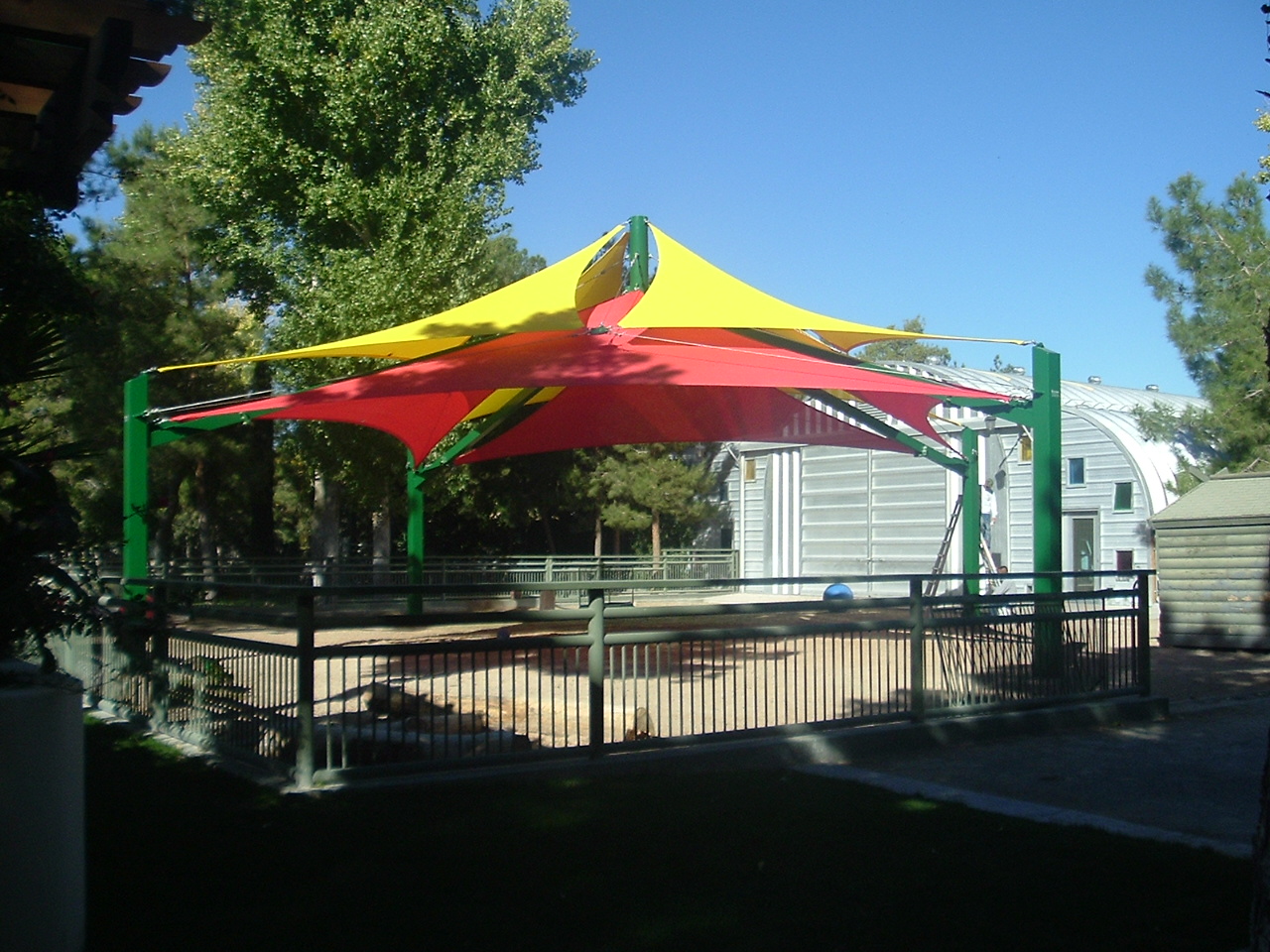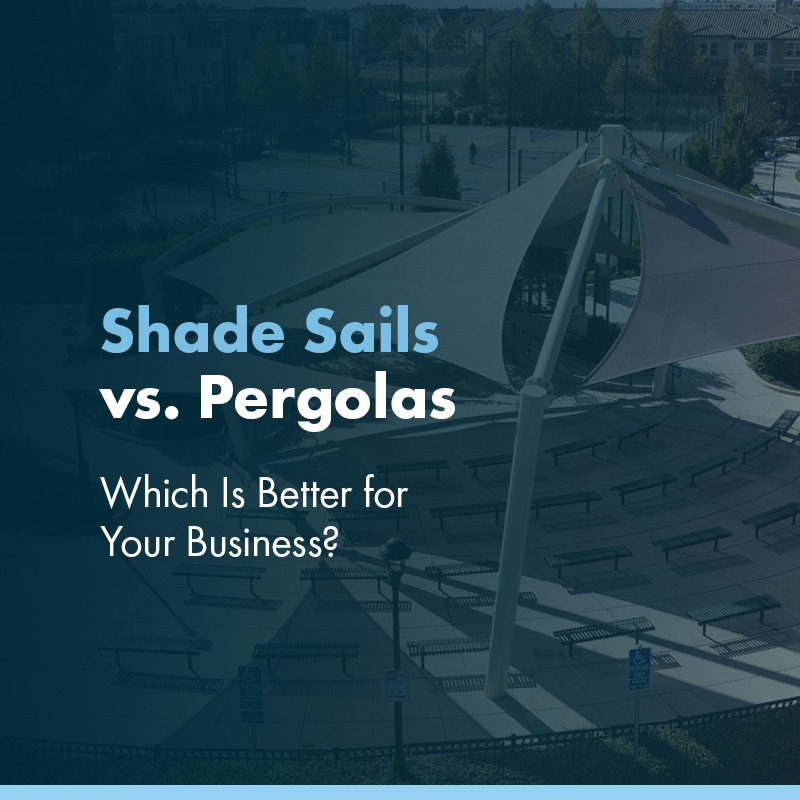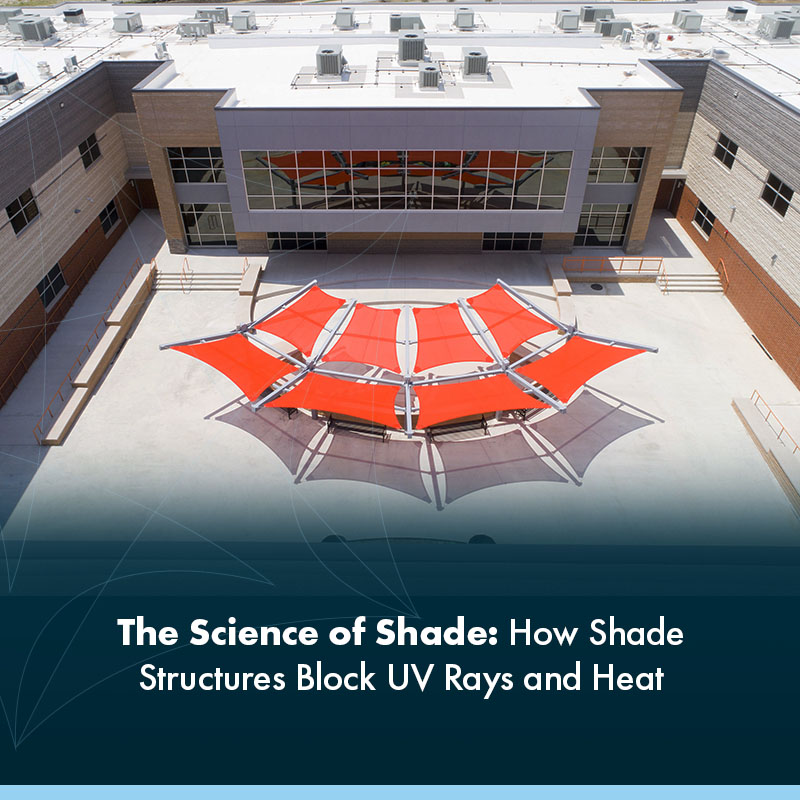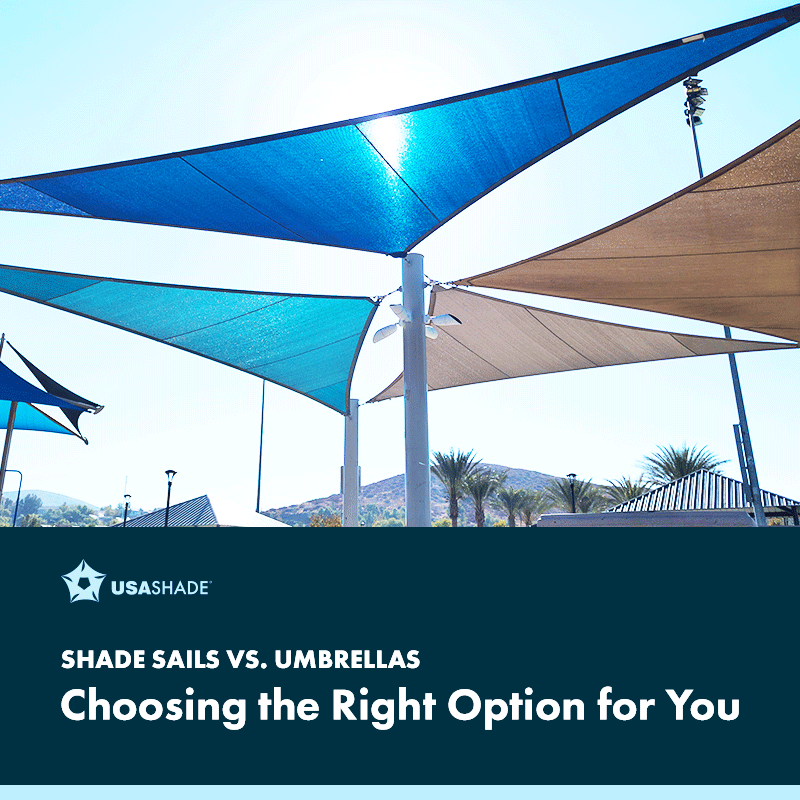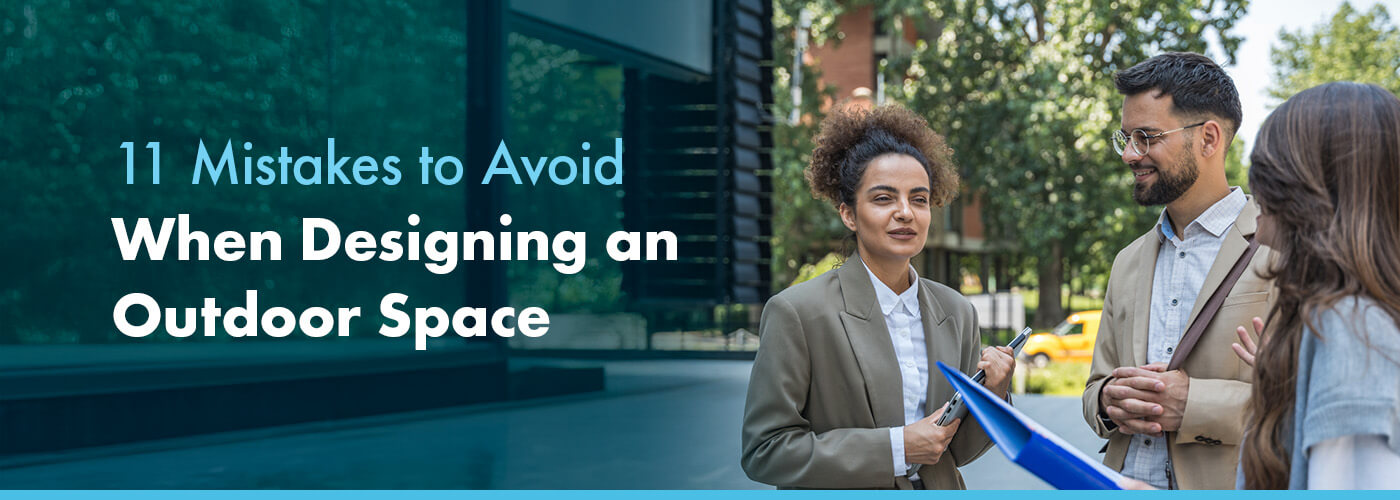
Designing a successful outdoor space is an exercise in art and science. A complex play of buildings, plants, shade structures and lighting — each detail crucial to the way people experience and enjoy the environment. Add to the mix client expectations, budgets and evolving visions and even the most experienced landscapers and architects can sometimes swing and miss.
In this outdoor design guide, we’ll explore the top 11 mistakes to watch for — and give actionable insights to help you create outdoor spaces that are beautiful, resilient and built to last.
1. Failing to Adapt Design for Climate Change
Landscapers and architects are under increasing pressure to deliver on sustainable design and meet requirements like the Sustainable Sites Initiative (SITES). The case for compliance is compelling — nature-based solutions can be constructed for 5% to 30% less cost and maintained for 25% less than conventional gray infrastructure.
As climate change accelerates, architects face new challenges when designing outdoor spaces — from rising temperatures and extreme weather to shifting precipitation patterns. Forward-thinking design responds to today’s climate but anticipates future conditions.
The following climate strategies can safeguard the long-term value of your projects for communities and clients:
- Explore the impacts of warming temperatures: Heatwaves, intense storms and unpredictable weather can affect how outdoor spaces are safely used over time. By building these realities into design, outdoor areas can be used for their intended purpose as conditions change.
- Use tools and resources during the design process: Climate projection tools and climate change resources can help with risk-based climate change vulnerability assessments, material selection, infrastructure planning and developing adaptation action plans.
- Include adaptation and mitigation strategies: Employ design solutions like increased shade structures for outdoor spaces, permeable surfaces for stormwater management, drought-tolerant landscaping and flexible infrastructure that can withstand extreme events. Consider renewable energy integration and passive cooling techniques to reduce environmental impact.
- Design for resilience and future-proofing: Plan for flexibility and scalability, allowing spaces to adjust as climate conditions shift. Engage stakeholders in scenario planning to ensure outdoor environments remain safe, functional, and inviting for years to come.
2. Neglecting Local Climate Considerations
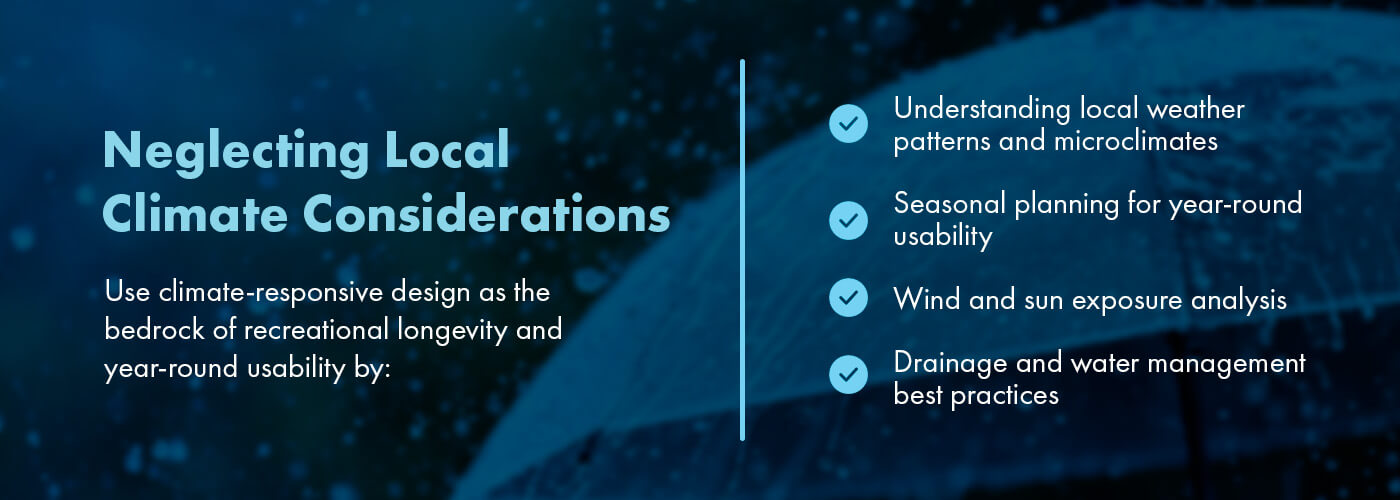
Overlooking local climate conditions is one of the most important mistakes to avoid when planning an outdoor space. Use climate-responsive design as the bedrock of recreational longevity and year-round usability by:
- Understanding local weather patterns and microclimates: Analyze sun, wind and precipitation patterns to inform layout, orientation and material choices.
- Seasonal planning for year-round usability: Consider how the space will function in different seasons and include features like shade, windbreaks or heating as needed.
- Wind and sun exposure analysis: Use site analysis to position structures and plantings for optimal comfort and protection.
- Drainage and water management best practices: Integrate drainage solutions to prevent flooding, erosion and water damage, protecting users and infrastructure.
3. Poor Space Planning and Traffic Flow
Thoughtful circulation and zoning optimize the appeal and functionality of a space. Simple solutions include:
- Well-defined walkways and routes allow smooth movement and prevent bottlenecks.
- Overcrowding can make areas feel chaotic and uncomfortable. Strategic spacing and thoughtful placement of features help maintain openness and usability.
- Dividing spaces into zones, like dining, play or relaxation, supports different uses and helps visitors intuitively navigate the environment.
- Planning accessibility for compliance and inclusivity makes spaces welcoming for everyone.
4. Ignoring Infrastructure Requirements
Infrastructure is often overlooked in early design stages, but it’s essential for functionality and long-term success. Planning for utilities and support structures results in harmonious integration and future flexibility.
Planning for Electrical, Water and Storage Needs
Anticipate the placement of power outlets for ambient, task and security lighting. Early planning allows for efficient conduit routing and avoids disruptive trenching after installation. Next, assess the need for automated irrigation systems, especially in regions with water restrictions or drought-prone climates. Plan main lines, control valves and access points for healthy plantings and efficient water use.
Include places to store maintenance equipment, seasonal furniture or event supplies. Integrating discreet storage solutions into the landscape design helps keep spaces organized and clutter-free.
Now, consider potential future needs, like electric vehicle (EV) charging stations, Wi-Fi infrastructure or additional utilities to minimize future disruptions and costs.
Support Structures for Shade Installations
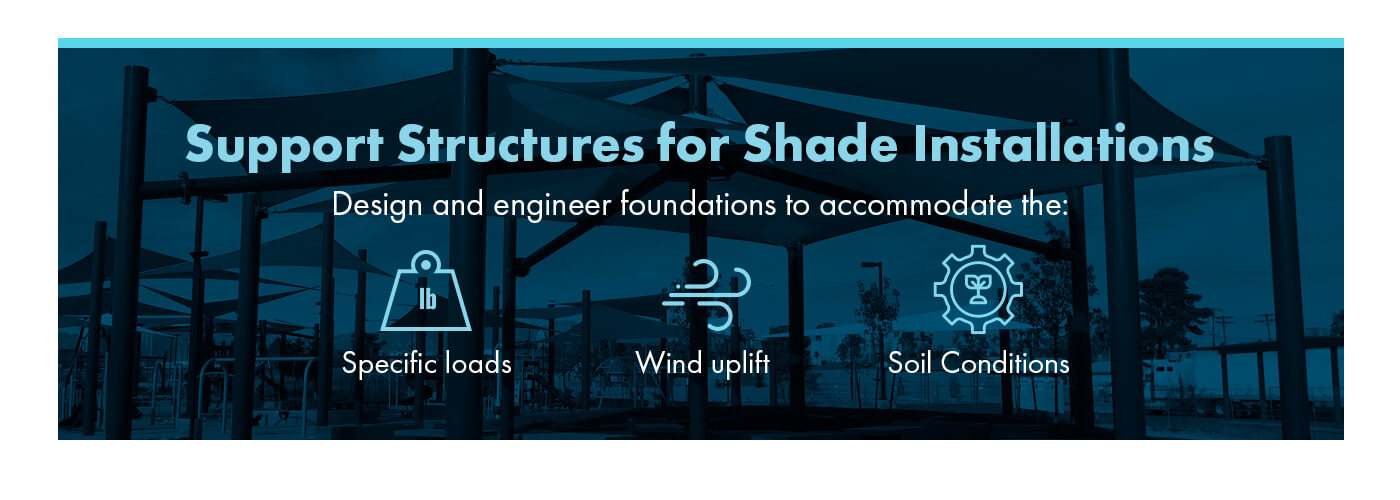
Design and engineer foundations to accommodate the specific loads, wind uplift and soil conditions of outdoor shade structures. Proper foundations are crucial for safety, stability and longevity. Coordinate with structural engineers so shade supports do not conflict with underground utilities or disrupt circulation paths. Also, plan for safe and convenient access to support structures for inspection and maintenance.
Blending Infrastructure Flawlessly Into Design
Conceal electrical conduits, irrigation lines and utility boxes in planters, under paving or behind architectural features to maintain a clean, cohesive appearance. When designing an outdoor space, it’s important to position infrastructure elements so they do not detract from sightlines, gathering areas or the overall ambiance of the space. Where possible, design infrastructure elements to serve dual purposes — like using shade structure columns to house lighting or speakers. This maximizes efficiency and minimizes visual clutter.
5. Overlooking Proper Shade Solutions
In commercial outdoor design, shade is a critical element that shapes how spaces are used and experienced. The right shade structure makes an area more inviting, functional and visually compelling for users year-round.
Since global climate records began in 1850, the 10 warmest years have happened in the last decade, 2015 to 2024. Forecasts expect temperatures to continue rising until at least 2050. With each passing year, premium outdoor shade structures are increasingly important to an area’s usability, particularly during peak sun hours, by protecting people, furnishings and surfaces from direct sunlight.
While UV protection is important for health, it also impacts user comfort. When a space is protected from the sun, visitors will use it more often and stay longer. This can increase the space’s value and popularity, supporting business and community goals. Well-designed shade structures can lower ambient temperatures by 10 degrees Fahrenheit, making outdoor spaces significantly more comfortable and reducing heat stress on users and materials.
Types of Commercial Shade Structures
When deciding how to design an outdoor space, you have many options depending on the aesthetics and functionality of your project. Common outdoor design mistakes include choosing inferior-quality products or structures that aren’t appropriate for a particular area and its purpose. For example, a location that experiences high precipitation or is used year-round would benefit from waterproof shade structures that are self-cleaning and have a 25-year lifespan. For large areas or challenging infrastructure, custom-designed shade structures can be integrated into any project.
6. Insufficient Plant Selection and Placement
Poor plant choices or placement can lead to high maintenance, poor growth or a lackluster appearance. Keep plants off the list of mistakes to avoid when designing an outdoor space by:
- Choosing climate-appropriate, low-maintenance plants for healthy growth and to reduce maintenance needs.
- Combining an evergreen or seasonal mix of plants for year-round color, texture and interest.
- Planning for the full size of plants at maturity to avoid overcrowding and allow for easy care.
7. Inadequate Seating and Gathering Areas
Seating and gathering spaces are essential for comfort, social interaction and functionality. Well-planned seating can enhance how people use and enjoy an outdoor area.
- Proper sizing and placement of seating areas: Seating areas can be thoughtfully sized and positioned to take advantage of scenic views, natural or built outdoor shade structures and amenities. Well-placed seating encourages people to linger, socialize and fully engage with the space.
- Importance of offering various seating options: A successful outdoor environment provides a variety of seating types to meet different user needs. Benches, movable chairs, picnic tables and group seating allow individuals, families and larger groups to find options that suit their preferences and activities. This diversity supports inclusivity and means the space remains welcoming and adaptable for all visitors.
- Integrating multi-functional spaces for flexibility: Designing flexible seating and gathering areas allows the space to adapt to different uses, from casual meetups to organized events or meetings. Multi-functional spaces can be easily reconfigured or expanded as needed, maximizing the value and versatility of the outdoor environment.
8. Improper Lighting Design
Lighting is a key factor in safety, usability and the character of a space. Poor lighting can feel unwelcoming or unsafe, while thoughtful design extends use into the evening and highlights architectural features. Use lighting in the following ways:
- Increase security and safety with adequate light to deter crime and accidents.
- Combine general illumination with focused lighting for pathways, signage and activity areas to enhance function and atmosphere.
- Use modern light-emitting diode (LED), smart and solar lighting systems to lessen energy costs and environmental impact while providing reliable illumination.
9. Failing to Consider Maintenance Needs
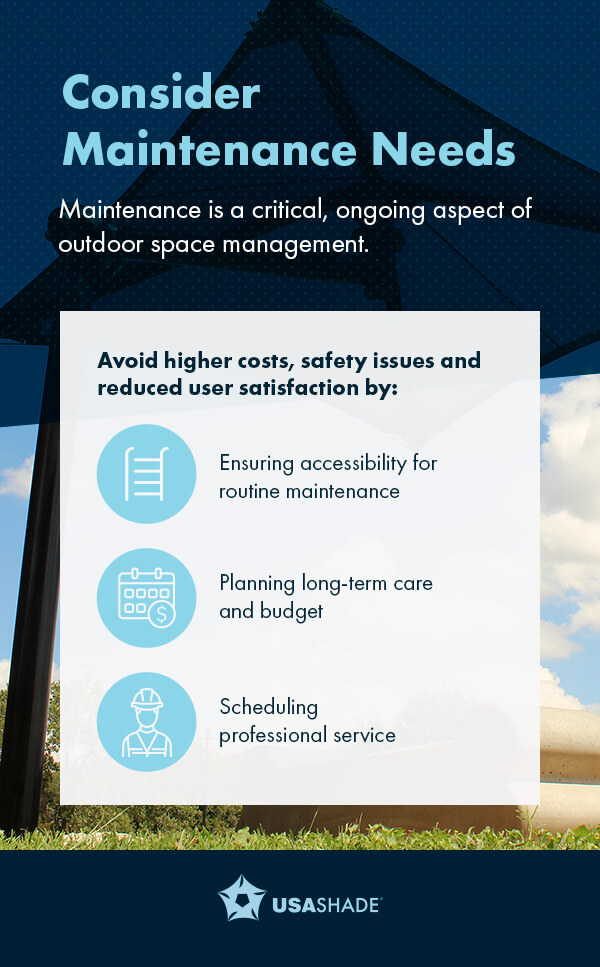
Maintenance is a critical, ongoing aspect of outdoor space management. Avoid higher costs, safety issues and reduced user satisfaction by:
- Ensuring accessibility for routine maintenance: Service providers or vehicles will need to be able to reach all areas for cleaning, repairs and landscaping.
- Planning long-term care and budget: Factor in the costs and resources needed for ongoing upkeep from the start.
- Scheduling professional service: Plan for regular inspections and professional maintenance to preserve quality and safety.
10. Not Planning for Future Growth
Failing to plan for the growth of a space is one of the most common mistakes to avoid when designing an outdoor space. Anticipate future needs and expansion so spaces remain relevant and valuable as demands change.
Scalability and Flexible Design Elements
Designing scalable and adaptable features is essential for future-proofing an outdoor space. Modular seating, movable planters and flexible shade structures can be easily reconfigured or expanded as user needs shift. This approach caters to incremental changes without requiring a complete redesign, making it easier to accommodate new activities, increased foot traffic or changing community preferences.
Future Expansion Possibilities
Leaving room for future amenities, structures or landscaping is a strategic way to support long-term growth. Identify potential areas for additional features — like new gathering zones, play equipment or event spaces — so these can be integrated when the time comes. Planning for expansion from the outset helps avoid costly and disruptive retrofits and ensures the space grows organically as the site develops.
Creating Adaptable Spaces
Designing multi-use areas that can serve different functions over time is key to maintaining an outdoor space’s relevance and utility. Open lawns, flexible plazas and convertible seating arrangements can support a variety of activities, from community events to quiet relaxation. This adaptability not only maximizes the space’s value but also ensures it continues to meet its users’ changing needs for years to come.
11. Failing to Use Professional Shade Solutions
Partnering with a professional shade provider like USA SHADE is one of the easiest ways to skip those outdoor design mistakes that might fall through the cracks. We bring expertise, innovation and reliability to your project for optimal results and long-term value.
Here’s why a professional partnership makes sense:
Advanced Protection and Comfort
Professional shade structures are engineered to provide advanced UV protection, significantly reducing exposure to harmful rays for everyone who uses the space. This enhances safety and increases comfort, encouraging longer stays and more frequent use. By prioritizing user well-being, these solutions help create inviting and protective outdoor environments.
Temperature Reduction and Extended Usability
One of the most immediate benefits of a well-designed shade structure is its ability to lower temperatures. This cooling effect makes outdoor spaces comfortable and usable even during periods of extreme heat, extending the hours and seasons in which the area can be enjoyed. As a result, spaces become more versatile and valuable for a wide range of activities.
Energy Efficiency and Sustainability
Outdoor shade structures contribute to energy efficiency by reducing the heat load on adjacent buildings. This can lower cooling costs and support broader sustainability goals. By integrating shade into the overall site design, projects can achieve better energy performance and demonstrate a commitment to environmental stewardship — an increasingly important consideration for clients and communities.
Enhancing Property Value and User Experience
A thoughtfully designed shade solution not only improves the day-to-day experience for users but also adds tangible value to the property. Attractive, functional shade structures can make a site more appealing to visitors, tenants or customers, helping to attract and retain users. Over time, this can translate into higher property values and a stronger reputation for quality and innovation.
Access to Design Resources and Technical Support
Working with a professional provider like USA SHADE gives designers and architects access to a wealth of resources, including design inspiration, technical expertise and project support. They offer tools and guidance to help bring your vision to life, with every project benefiting from the latest innovations and best practices in shade structure design.
Ready to Transform Your Outdoor Space?
At USA SHADE, we’ve been assisting designers, architects, landscape architects and business owners in bringing their visions of outdoor spaces to life for more than 30 years. We are pioneers, innovators and long-standing leaders of the North American fabric shade structure industry. More than 300,000 shade structures later, what we value most are the ongoing partnerships with our clients.
Connect with us for expert support, inspiration and resources tailored to your project’s needs — whether you need a fast, quick ship solution or a custom design to set your project apart, we can turn your ideas into real-world solutions.


